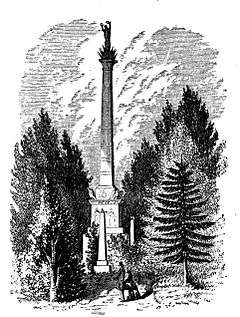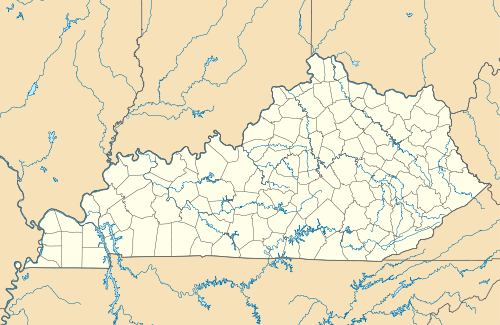Kentucky War Memorial
| Kentucky War Memorial | |
|---|---|
 | |
| Type | Military Memorial |
| Location | Frankfort, Kentucky |
| Coordinates | 38°11′37″N 84°51′53″W / 38.19361°N 84.86472°WCoordinates: 38°11′37″N 84°51′53″W / 38.19361°N 84.86472°W |
| Built | 1850 |
| Sculptor | Robert E. Launitz |
 Location of Kentucky War Memorial in Kentucky | |
The Kentucky War Memorial in Frankfort Cemetery in Frankfort, Kentucky, is a monument dedicated to fallen Kentucky officer who perished in American wars of the 19th century. On February 25, 1848, an act passed by the state legislature appropriated $15,000 for its construction.[1] The 65-foot-tall granite monument, topped by a statue of Victory, was unveiled in 1850.
The monument is situated on the cemetery's "State Mound," and was erected to stand over the graves of 17 Kentucky soldiers who had fallen at the Battle of Buena Vista. Their interment in Frankfort Cemetery on July 20, 1847 was marked by a eulogy from John C. Breckinridge, a supporter of the war. According to a popular story, this mass funeral inspired Mexican-War veteran, Theordore O'Hara, to pen his famed poem, "Bivouac of the Dead". However, O'Hara was still with the army in Mexico in July 1848.[2]
Inscriptions
South side
The south side of the monument features the coat of arms of Kentucky and the state motto, "United we stand; divided we fall."[3]
This side is inscribed with the names of those officers killed at St. Clair's Defeat, Estill's Defeat, Tippecanoe, Fort Meigs, and Blue Licks.
North side
The north side of the monument is inscribed with the names of those officers killed at Boonesborough, Harman's Defeat, Wayne's Campaign, the River Raisin Massacre, and during the Mexican–American War.
West side
The west side of the monument is inscribed with the names of those officers killed at Thames, the River Raisin Massacre, at Little Bighorn, and during the Indian Wars.
East side
The east side of the monument is inscribed with the names of three Kentucky naval officers who drowned during the early 1870s: John Gunnell Talbot, Hugh McKee, and Alfred Foree.
References
- ↑ Johnson, Lewis Franklin (1921). History of the Frankfort Cemetery. Frankfort, KY: Roberts Printing Company. p. 13 – via Google Books.
- ↑ Ramage, James A.; Watkins, Andrea S. (2011). Kentucky Rising: Democracy, Slavery, and Culture from the Early Republic to the Civil War. Lexington, KY: University Press of Kentucky. pp. 184–185 – via Google Books.
- ↑ Johnson. History of the Frankfort Cemetery. p. 14.
External links
- Kentucky Archaeological Survey of the Military Monument, by the Kentucky Heritage Council
- An address on the occasion of the burial of the Kentucky volunteers, who fell at Buena Vista, delivered by John C. Breckinridge on July 20, 1847